2 JULY 2018
YOUR WORDS
Readers are invited to add their comments to any story. Click on the article to see and add.
BTN DISTRIBUTION
BTN also goes out by email every Sunday night at midnight (UK time). To view this edition click here.
The Business Travel News
PO Box 758
Edgware HA8 4QF
United Kingdom
info@btnews.co.uk
© 2022 Business Travel News Ltd.
Article from BTNews 2 JULY 2018
ON TOUR: Paris to Paris on the Seine
If you have never been to Normandy there is no better way of an introduction than by joining a river cruise down the Seine from Paris for the 277 miles to the sea.
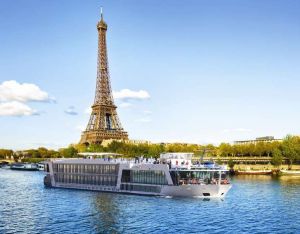 Synonymous with the French capital the river is the second longest in France, and rises near Dijon. Ocean-going vessels can navigate up to Rouen, 75 miles from the river’s mouth. For your editor-in-chief it was a real eye-opener, and a most enjoyable one.
Synonymous with the French capital the river is the second longest in France, and rises near Dijon. Ocean-going vessels can navigate up to Rouen, 75 miles from the river’s mouth. For your editor-in-chief it was a real eye-opener, and a most enjoyable one.
We took Eurostar from St Pancras non-stop in 2hr 16mins to Garde du Nord, with the on-board café offering a decent and fairly priced selection for those who were taking the early morning departure. Plenty of space for bags and help available with getting up the steps. Either 1+1, or 2+2 with a table between so a family of four can sit facing each other with a large table to put food, laptops or other things to keep occupied, and on the website it costs you nothing to move the allocated seating.
The latest digitised border control at check-in and it is straight out upon arrival.
Connecting on the free station wi-fi an Uber taxi was soon found and for €23 (fares vary according to the time of day and potential traffic) and in 20min we were at Port de Javel Bas, close by the Eiffel Tower and a simple step on to AmaWaterways AmaLyra, our home for the next eight days. (See Also BTN July Cruise Issue)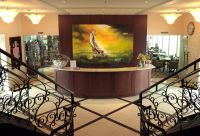 A river cruise is a totally different concept to a seaborne trip. It is best to compare with a coach or car holiday with the same accommodation every evening and without the need to repack every morning. You can treat it as a cycle holiday too. AmaLyra has 20 bikes on board and an experienced leader to act as the chaperon for a tour at every port. Unlike the other passengers you cannot use the (excellent) personal audio devices to keep in touch with the guide, more’s the pity, but the French police say they can be a distraction. Helmets are a must and supplied.
A river cruise is a totally different concept to a seaborne trip. It is best to compare with a coach or car holiday with the same accommodation every evening and without the need to repack every morning. You can treat it as a cycle holiday too. AmaLyra has 20 bikes on board and an experienced leader to act as the chaperon for a tour at every port. Unlike the other passengers you cannot use the (excellent) personal audio devices to keep in touch with the guide, more’s the pity, but the French police say they can be a distraction. Helmets are a must and supplied.
The holiday can be tiring but there were always three grades of tour from easy, middle of the road, and just that little bit harder. The first stop Les Andelys, overnight from Paris, typified the trip. You could visit Richard the Lionheart’s castle by coach, walk down, or climb the 600 steps each way.
AmaLyra was one the first modern AmaWaterways river ships built in 2009 and constantly updated. The width is the standard 11.5m required for most of the locks on the European rivers but at 110m is shorter than some, hence its lower capacity of 146 passengers looked after by 46 crew. 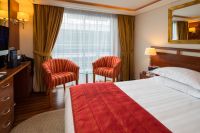 Except for the fact it is less crowded than the longer ships in most respects it is typical of all the AMA fleet. As you enter there is a spacious atrium and reception area, shop, elevator, a library come lounge, with the staterooms on three decks towards the stern, along a single corridor. At the back is a small gym, beauty salon and the Chef’s Table speciality restaurant, featuring a paired tasting menu, the same every night in order for all passengers to sample the exquisite French fayre prepared in the open kitchen. With large glass windows, and the ship under way, it really is a pleasant way to spend an evening.
Except for the fact it is less crowded than the longer ships in most respects it is typical of all the AMA fleet. As you enter there is a spacious atrium and reception area, shop, elevator, a library come lounge, with the staterooms on three decks towards the stern, along a single corridor. At the back is a small gym, beauty salon and the Chef’s Table speciality restaurant, featuring a paired tasting menu, the same every night in order for all passengers to sample the exquisite French fayre prepared in the open kitchen. With large glass windows, and the ship under way, it really is a pleasant way to spend an evening.
The great majority of the cabins are the same size, 170sq ft with the so-called French Balcony, not really at balcony at all just an extension giving that bit more room. It works very well and is better than the offering on some ships that takes away the floor space. With AmaMagna (see BTN July Cruise issue) the plan is to divide the area with a glass partition, a system that works well and is provided by some operators. 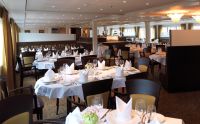 For a one-week cruise there is plenty of cupboard room, the latest Apple TVs with keyboard and mouse for free wi-fi connection and a dressing table that doubled up as laptop space. The bathroom (a glass enclosed multi-jet shower is provided) is nicely turned out in marble. No cabin service as such, but it is not really needed, and an evening ‘turndown’ visit. You get a choice of pillows. Cabins on the waterline level are the same size as those above but suffer from a claustrophobic hemmed in feeling and are not recommended unless you are never going to use them daytime and want very good value for money.
For a one-week cruise there is plenty of cupboard room, the latest Apple TVs with keyboard and mouse for free wi-fi connection and a dressing table that doubled up as laptop space. The bathroom (a glass enclosed multi-jet shower is provided) is nicely turned out in marble. No cabin service as such, but it is not really needed, and an evening ‘turndown’ visit. You get a choice of pillows. Cabins on the waterline level are the same size as those above but suffer from a claustrophobic hemmed in feeling and are not recommended unless you are never going to use them daytime and want very good value for money.
The front is on two floors with a lounge above and restaurant underneath. Both are nicely laid out with the décor best described as traditional. From the lounge you can sit out in the open over the bow and watch the view. An early morning light breakfast is served in this salon and also a buffet lunch, afternoon tea and late-night snacks. It is also the venue for port briefings and the excellent Edith Piaf tribute show.
Every evening there is a courtesy ‘sip and serve’ hour, the tours are all included but with AMA it is suggested you give an overall tip to the crew, and perhaps also the local specialist guides. French wines are served at all mealtimes, plus beers and soft drinks. As one would expect from a member of La Chaîne des Rôtisseurs, the exclusive international culinary society, the locally-inspired cuisine is top quality served by a well-trained team.
With a busy daytime schedule most evenings are spent quietly the (pay) bar open late. There is always a variety of teas and coffees available courtesy of AMA. 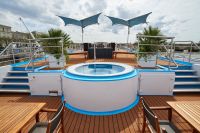 The top deck includes a hot tub, 100m walking track, a one hole putting green, giant size chess set and an area for the wellness director to brief his regulars every morning. This programme is said to be unique to AMA passengers.
The top deck includes a hot tub, 100m walking track, a one hole putting green, giant size chess set and an area for the wellness director to brief his regulars every morning. This programme is said to be unique to AMA passengers.
There are no off-ship social activities and virtually every village/small town we visited had a very helpful information centre always just a short walk from the ship. No charging for rest rooms either. Judging by the brochures on view there is an amazing number of things to do in Normandy.
A nice touch is a free postcard service. People don’t send them these days, but as a guest of AMA you can write to the family. On the shorter cruises it may arrive after you get home, but is still received with gratitude.
AND THE TRIP DOWN THE SEINE
The following short paragraphs are but a pen picture of an area always popular with the English, now for second homes, but for hundreds of years fought over for dominance with the French crown. Queen Elizabeth II is Duke of Normandy but try to explain that hereditary title to Americans who made up 90% of the passengers on the cruise. The local English speaking guides in all places were excellent,
www.eurostar.com
www.amawaterways.com
http://en.normandie-tourisme.fr/normandy-tourism-1-2.html
Les Andelys and Château Gaillard (Day 2)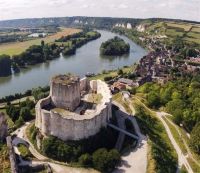 The first stop, in effect the second day, was the pretty riverside village of Les Andelys with its restaurants and church before a short coach trip to Château Gaillard, 300ft above the commune and built in just two years from 1196 to 1198 under the scrutiny of Richard the Lionheart, King of England and Duke of Normandy, a remarkable feat. Thought to be impregnable it was taken by the French King Phillipe II in 1204 after a lengthy siege. The ruins were very impressive.
The first stop, in effect the second day, was the pretty riverside village of Les Andelys with its restaurants and church before a short coach trip to Château Gaillard, 300ft above the commune and built in just two years from 1196 to 1198 under the scrutiny of Richard the Lionheart, King of England and Duke of Normandy, a remarkable feat. Thought to be impregnable it was taken by the French King Phillipe II in 1204 after a lengthy siege. The ruins were very impressive.
Next short halt late evening was Rouen, in the very centre of a 300,000 population city. An escorted short walk found most of the AMA guests outside the Cathedral for the remarkable light and music show this year based on the Vikings and Joan of Arc, burnt at the stake in Rouen. Using the façade of France’s largest cathedral, it is not a laser show but a designer projection which lasts for 20min. It is quite remarkable.
www.ville-andelys.fr/office-tourisme
Honfleur excursion from Le Havre (Day 3)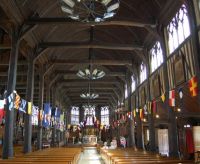 The name comes from old Norse and is nothing to do with flowers. Whilst some took the city tour of the port city virtually destroyed in WWII we revisited Honfleur (see BTN 1 August 2016) via the amazing Le Pont de Normandie cable-stayed road bridge opened on 20 January 1995 and once the longest of its type in the world.
The name comes from old Norse and is nothing to do with flowers. Whilst some took the city tour of the port city virtually destroyed in WWII we revisited Honfleur (see BTN 1 August 2016) via the amazing Le Pont de Normandie cable-stayed road bridge opened on 20 January 1995 and once the longest of its type in the world.
Unlike many of its Normandy neighbours, Honfleur was spared during the bombing of WWII. Nestled in its tidy, picturesque streets are historic buildings, housing art galleries, artists’ studios, boutiques, restaurants, cafés and fine souvenir shops.
“ABC” is a common expletive on this type of trip (Another B----- Church) but the wooden Saint-Catherine's at Honfleur is exceptional, internal roof timbers built by local shipwrights and is a must.
After a quick lunch it was into the coach again, this time for a look at the Normandy countryside and the picture post card village of Beaumont en Auge. We were of course now deep into cider territory, the Drouin Estate hosting a visit and tasting into the art of Calvados, the local apple-based brandy.
www.honfleur-tourism.co.uk
D-Day and the British/Canadian beaches (Day 4)Watch Darryl F. Zanuck’s 1962 epic black and white war film “The Longest Day” before you visit the Normandy beaches. Those of a certain age can spot the actors who took part including a wonderful cameo by Richard Burton who shot his two scenes for free in a single day.
On the evening prior to our visit we were treated to a one hour presentation by Nigel Stewart not on D-Day itself but more on the war in Europe and the efforts and sacrifices of so many.
Our D-Day tour started with visits to two mainly British and Canadian cemeteries, out of 18 kept in wonderful condition by Commonwealth War Graves Commission. The United States decided to create a single cemetery overlooking Omaha beach with families offered the choice of internment back home. Some 9,000 US citizens are buried including Theodore Roosevelt, Jr, son of President Theodore Roosevelt, who at the age of 57 went ashore with the first wave and a month later died of a heart attack and two of the Niland brothers which the film “Saving Private Ryan” was loosely based.
The Pegasus Bridge and the Memorial Museum is a must for any British visitor and is where the men of D Company, 2nd Oxfordshire and Buckinghamshire Light Infantry (part of the 6th British Airborne Division) landed by Horsa glider in the early hours of 6th June. Troops led by Major John Howard captured the Caen Canal Bridge. Richard Todd played John Howard in the film and in real life took part in the action.Arromanches, now a lively seaside town, was briefly visited to see the remains of "Port Winston" the Mulberry harbour. No time to view the museum as Gold Beach had to be seen, now, as then, at low tide and a perilous 300 yards to traverse before getting close to the sand dunes and some sort of protection from the German guns.
Our last tour of a memorable day was Juno, the Canadian beach and the museum and cultural centre dedicated to the 5,500 Dominion volunteer service personnel who lost their lives in the Normandy campaign. Worth noting is the student guide programme which brings over youngers from Canada to act as attendants and to spread knowledge to their compatriots when they return home. https://ddaylectures.com
http://en.normandie-tourisme.fr/things-to-do/sites-and-attractions/d-day-and-the-battle-of-normandy-113-2.html
Rouen (Day5)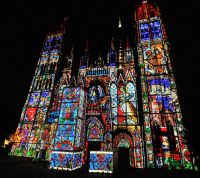 During WWII 45% of Rouen was destroyed but the city has been remarkably restored with the medieval quarter and its narrow lanes bustling and full of shops and eating places, the centre dominated by the massive Gothic cathedral, the final spire, in black, still under construction with completion said to be 2024.
During WWII 45% of Rouen was destroyed but the city has been remarkably restored with the medieval quarter and its narrow lanes bustling and full of shops and eating places, the centre dominated by the massive Gothic cathedral, the final spire, in black, still under construction with completion said to be 2024.
It was in Rouen that Joan of Arc was held and burnt at the stake for heresy in 1431. The then Pope declared her a martyr 24 years after her death. Today the site of her death is a small garden, part of a market square dominated by the modern catholic church (1979) named after her.
At Rouen the walking is flat and it is possible to take the morning tour and luncheon back on the ship, or turn the day into a gastronomic affair at one of the fine dining restaurants in the rue Martainville.
Jews have generally flourished in Rouen since the times of the Romans but the entire population was wiped out by the Nazis. Our afternoon walk took us to the rebuilt synagogue (1950) in the centre of the city and an introduction by the community secretary explaining that today the congregants (250 families) are mainly from Morocco with a Rabbi from Paris resident over the weekend.
http://en.rouentourisme.com
Vernon (Day 6)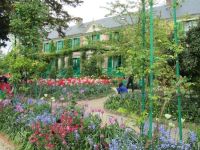 The small municipality of Vernon was founded by Rollo, the first Duke of Normandy and today is best known for its vicinity to both Giverny and the painter Claude Monet’s house, and the Château de Bizy.
The small municipality of Vernon was founded by Rollo, the first Duke of Normandy and today is best known for its vicinity to both Giverny and the painter Claude Monet’s house, and the Château de Bizy.
By all accounts the visit to Monet’s house was less than it could have been with heavy crowds it not proving possible to view the paintings properly. The gardens in many ways made up for the disappointment, across the street the oriental water gardens described as “magnifique”.
The Château de Bizy by contrast was less busy and is still the residence of a descendent of Napoléon III (perhaps AMA could somehow fit both in?). The drive up from the river is partly in an impressive avenue, reminiscent of Windsor Castle's own ceremonial entrance. It has been nicknamed "Normandy's Versailles" because of its large stable and gardens but that is something of an exaggeration.
The neo-classical style manor house dates back to the mid-19th century, but the stables are almost 200 years older. The property is well endowed with artefacts from all over Europe, the last King of France a collector who preferred the quietness of Vernon to the noise of Paris.
www.conflans-tourisme.fr
Conflans (Day 7)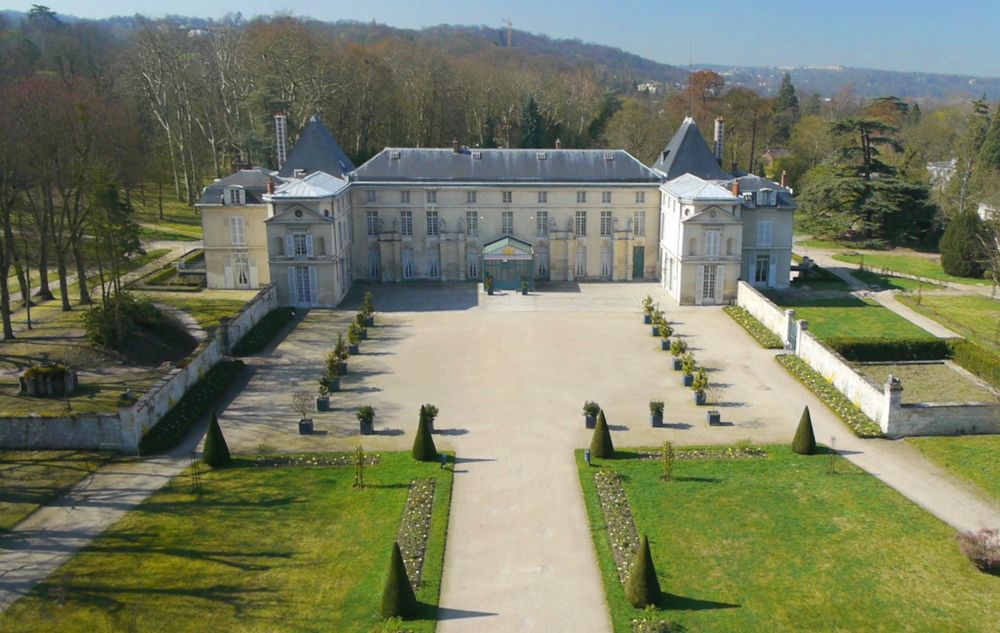 The Château Malmaison is on the outskirts of Paris but clearly in the late 18th century best approached from the Seine. Having lost her husband during the reign of terror Joséphine de Beauharnais fell in love with the young General Napoléon Bonaparte, and whilst he was away fighting in Egypt, as his wife, purchased the property in 1799. She was known for her extravagance and he was none too pleased. She was to die in the palace in 1814 and in 1815 it was Napoléon’s last residence in France.
The Château Malmaison is on the outskirts of Paris but clearly in the late 18th century best approached from the Seine. Having lost her husband during the reign of terror Joséphine de Beauharnais fell in love with the young General Napoléon Bonaparte, and whilst he was away fighting in Egypt, as his wife, purchased the property in 1799. She was known for her extravagance and he was none too pleased. She was to die in the palace in 1814 and in 1815 it was Napoléon’s last residence in France.
The love of his life Napoléon divorced the unproductive Joséphine in order to remarry and continue the line. It’s a complicated tale!
.
In many ways the château is something less than it should have been, whilst full of memorabilia, furniture and paintings from the Napoleonic era it does not have the flare of a typical English country mansion from the same era. There is also a small exhibition of Napoléon’s exile to St Helena (See BTN 16 October 2017) tucked away on an upper floor.
www.conflans-tourisme.fr
OUR READERS' FINEST WORDS (All times and dates are GMT)
All comments are filtered to exclude any excesses but the Editor does not have to agree with what is being said. 100 words maximum
